Blog about successful marketing strategies in russia
Features of Indoor advertising placement in the Russian subways


MEDIA BUYING
Share this Post
In Russia, the metro is not just a means of transportation; it's a media environment with a multimillion-strong audience, stable coverage, and effective indoor formats. If you are promoting goods or services in the Russian market, advertising in the metro is a tool you should consider first.
In the first quarter of 2024 alone, passengers of the Moscow metro made over 570 million trips. For comparison, this is four times more than the entire population of the country. On December 12, an absolute record was set — 8.3 million passengers in one day. This is 5.8% more than the same day the previous year and the highest figure in the last four years.
In 2024, the positive trend continued: passenger traffic in the Novosibirsk metro increased by 1.9%, while in the Kazan metro it grew by 11% compared to the year before last.
The subway is used by millions of people from all walks of life: children, pensioners, students, working people, businessmen, and entrepreneurs. A huge passenger flow of people passes through the entrance, through turnstiles, lobbies, and escalators along long corridors and passages to stations and into train cars daily. At each movement stage, they are met by indoor advertising of various formats and levels: screens, light boxes, stickers along escalators and on station platforms, and advertising in subway cars.
At the same time, 75.7% of Russia's population lives in cities, and over 90% are active Internet users. However, digital channels don't reach everyone. Indoor advertising in the subway fills this gap: it enhances digital campaigns through direct call-to-action, short domains, and brand geotags on the passenger's route. In some cities (like St. Petersburg), QR codes can be used in ads, but their placement is officially prohibited in the Moscow subway. Therefore, other engagement tools are used there, such as navigation prompts, NFC tags, and concise offline calls to action.
Why is the subway more effective than other offline locations? It's simple: it provides repeated exposure to advertising, with no distractions in the background. According to Datareportal, Russians spend an average of 2 hours and 23 minutes on social media and 3 hours and 24 minutes watching TV. But on a phone, there are always several tabs open, notifications popping up, and music playing in the background. In the subway, there are no unnecessary screens. Yes, the phone is still nearby, but attention is often scattered during the journey: some are tired, others simply stare ahead, and some don't want extra noise. And here comes the advertising message. The subway offers a space where the ad field doesn't flicker but accompanies passengers. Even the largest airports can't offer so many surfaces and such a frequency of contact.
Subway advertising is when you're seen. Every day. Without scrolling, blocking, or algorithmic filters.
Fast Overview of Top five Russian subways
Moscow and St. Petersburg have the largest subways. They are, in fact, entire "cities underground." The subways in Novosibirsk, Nizhny Novgorod, and Kazan are much more modest, consisting of one or two branches.
Moscow subway
The Moscow Metro has a long and illustrious history, dating back to 1935. According to the latest data, the passenger flow of the Moscow metro is 2.169 million people per year, which is almost twice as much as all other metros in Russia combined. It is the busiest in Russia, with 2169.4 million passengers annually. That's almost twice as many as the next busiest subway system. The Moscow Metro has 16 lines and 271 stations. These figures are not final. It is constantly growing in size, new stations are being opened, branches are being extended, and new ones are being built. The stations are worthy of special mention. Each has its own history and its own unique charm and style.
St. Petersburg subway
It is the second-largest metropolitan area in Russia.
It consists of 5 lines and 73 stations. The operational length of the lines is 128.4 km. In 2024, the passenger flow reached 686.1 million people, which is an increase of 83.0 million (13.8%) compared to 2023 (603.1 million passengers).
The Saint Petersburg metro is notable for its record depth in the country. It is about 50-60 meters, with some stations going much deeper. For example, Admiralteyskaya one is 86 meters deep (the deepest station in Russia and one of the deepest in the world). Some metro stations are recognized landmarks of the city. For example, the Alexander Nevsky Square 2 station was built in the style of an ancient fortress.
Novosibirsk subway
This metro is unquestionably the longest metro bridge in Russia and the easternmost metro in the country. Its passenger flow amounted to 86.1 million people for 2024. It consists of two lines and 13 stations. The subway was founded in 1986 and has transported more than 2.5 billion people during its entire existence.
Nizhny Novgorod subway
It is the fourth largest metro in Russia in terms of passenger traffic. In 2024, the Nizhny Novgorod metro transported 35.9 million passengers, which is a 7.5% increase compared to 2023. The metro was founded in 1985 and consists of two branches and 15 stations. It is worth noting that the four-track station Moskovskaya was first introduced here, and in 2017, Nizhny Novgorod residents were the first in the country to use contactless fare payment.
Kazan subway
It is the youngest metro in Russia opened in 2005.
Kazan Metro saw a continued upward trend, with passenger numbers reaching 39.4 million, an 11% increase compared to 2023 (35.5 million). This growth is driven by the expanding population, enhanced urban infrastructure, and the integration of digital services into the transportation system.
The Kazan Metro has just one branch and 11 stations, a total length of 17 km. The central metro stations are unquestionably the city's landmarks. They are stylized under Tatar architecture and mythology.
| Subway | Passenger traffic per year, mln |
|---|---|
| Moscow Metro | 2,200.0 |
| Saint Petersburg Metro | 686.1 |
| Novosibirsk Metro | 86.1 |
| Kazan Metro | 39.4 |
| Nizhny Novgorod Metro | 35.9 |
Basic Indoor Ad formats in Russian subway
Russia's subways carry three billion passengers a year. It is the largest advertising platform with a huge reach. The metro area is full of various advertising media, including billboards on escalators, digital city-formats at stations, light panels and lightboxes in lobbies and passages, stickers on turnstiles, navigation signs, and advertising on vending machines and in train cars. The metro is rapidly developing in both the capital and the regions. New stations are appearing, the number of trains is increasing, and passenger traffic is growing.
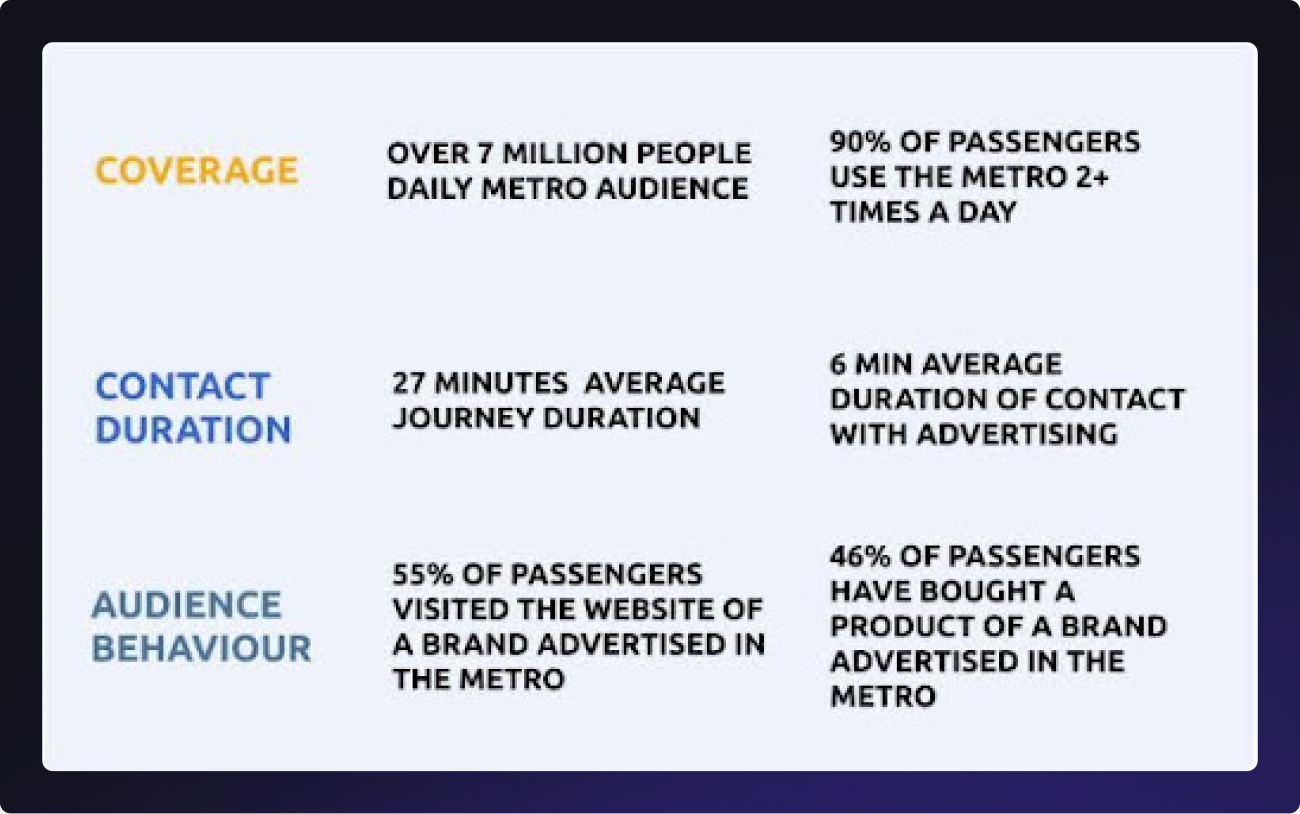
Moscow Metro audience
Let's take a look at the most common indoor advertising formats in Russian subways.
Digital city format in the subway
These are high-definition LED screens. They broadcast video clips. These structures are installed on subway platforms in places where large crowds of passengers wait for their trains. This format of placement allows for successful image and navigation advertising campaigns. The size of the advertising structure varies, but the most common are digital screens measuring 1.28×1.76 meters.
These screens are one of the most popular and in-demand advertising formats in the metro. They are noticeable, dynamic, and do not require any effort from the passenger to perceive as the message simply appears before their eyes at the right moment.
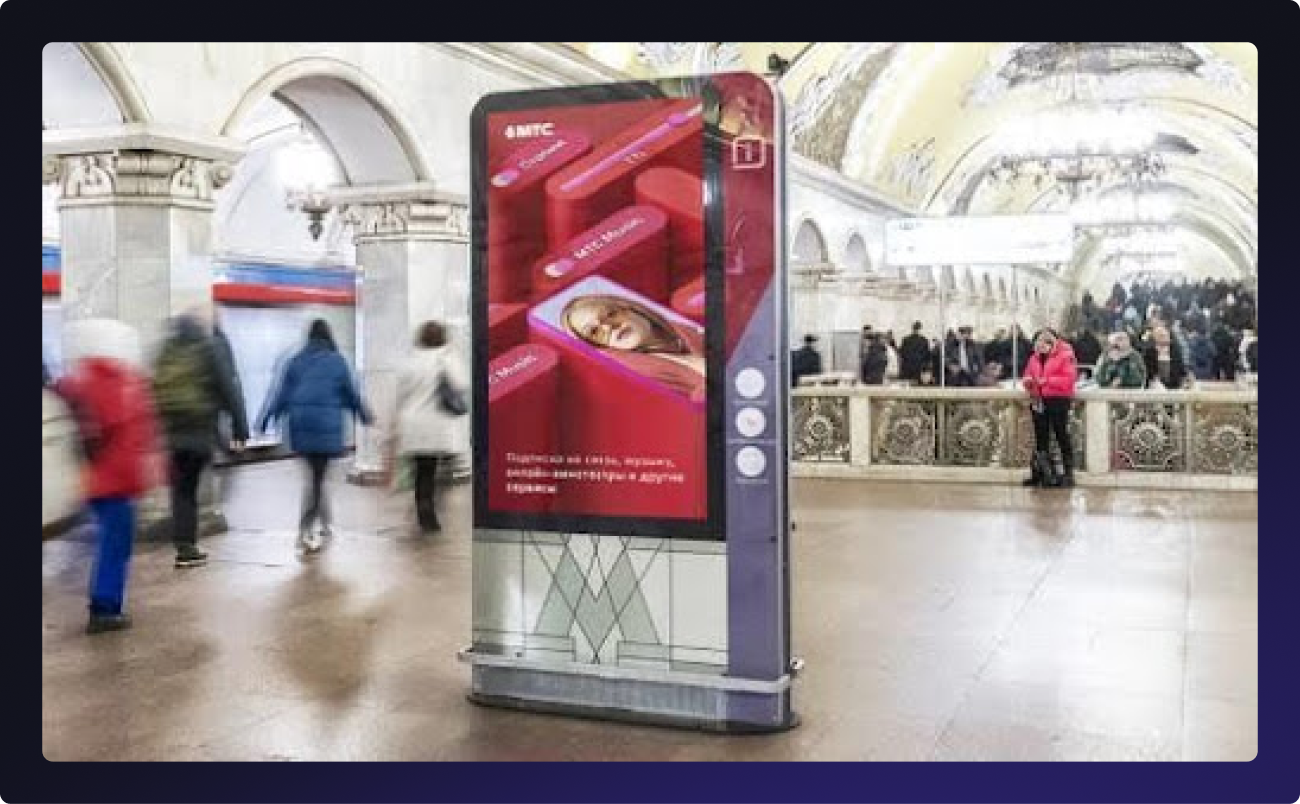
Digital city-format on the platform of VDNKh station of the Moscow Metro's Kaluzhsko-Rizhskaya line
Digital screens in the subway
Digital screens come in a variety of sizes. As with the city format, they are installed in the areas of the highest passenger traffic flow: lobbies, crossing points, metro entrances, and exits, and near stairs and escalators. They allow content to be changed based on the time of day and target specific traffic.
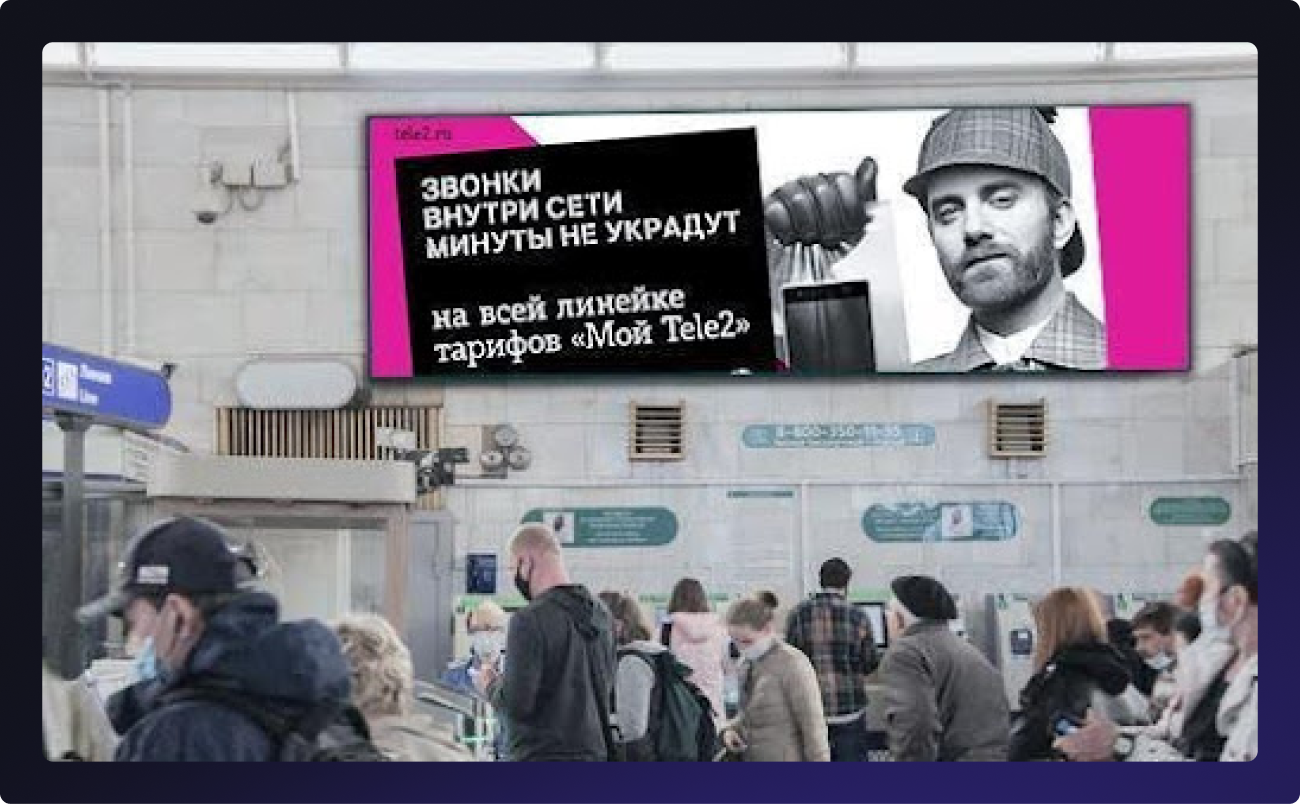
5.12×1.66 m digital screen in the lobby of the St. Petersburg metro station
Advertising stickers in the subway
Advertising stickers are placed in subway cars. To maximize the effect of this format, the creative must be placed in an easily viewable and readable layout in places of frequent eye contact with passengers. It must be placed in a position that allows it to be seen by both seated passengers and those standing in the aisle of the car. They are especially effective in B2C sectors such as cosmetics, retail, and finance. The key is a clear, readable message and well-designed visuals.
As practice shows, a combination of high-quality visuals and additional thoughtful storytelling can have a particularly strong impact. In September 2024, the telecom operator T2, together with Russ, the media group and outdoor advertising operator, implemented a large-scale branding project on two Moscow metro trains. Each of the eight carriages was decorated with the new T2 branding, and the advertising materials inside created a cohesive and consistent brand story for passengers. The trains operated on the busiest lines, ensuring stable contact with the audience throughout the entire trip.
Here's an example of how another brand designed a metro train carriage.
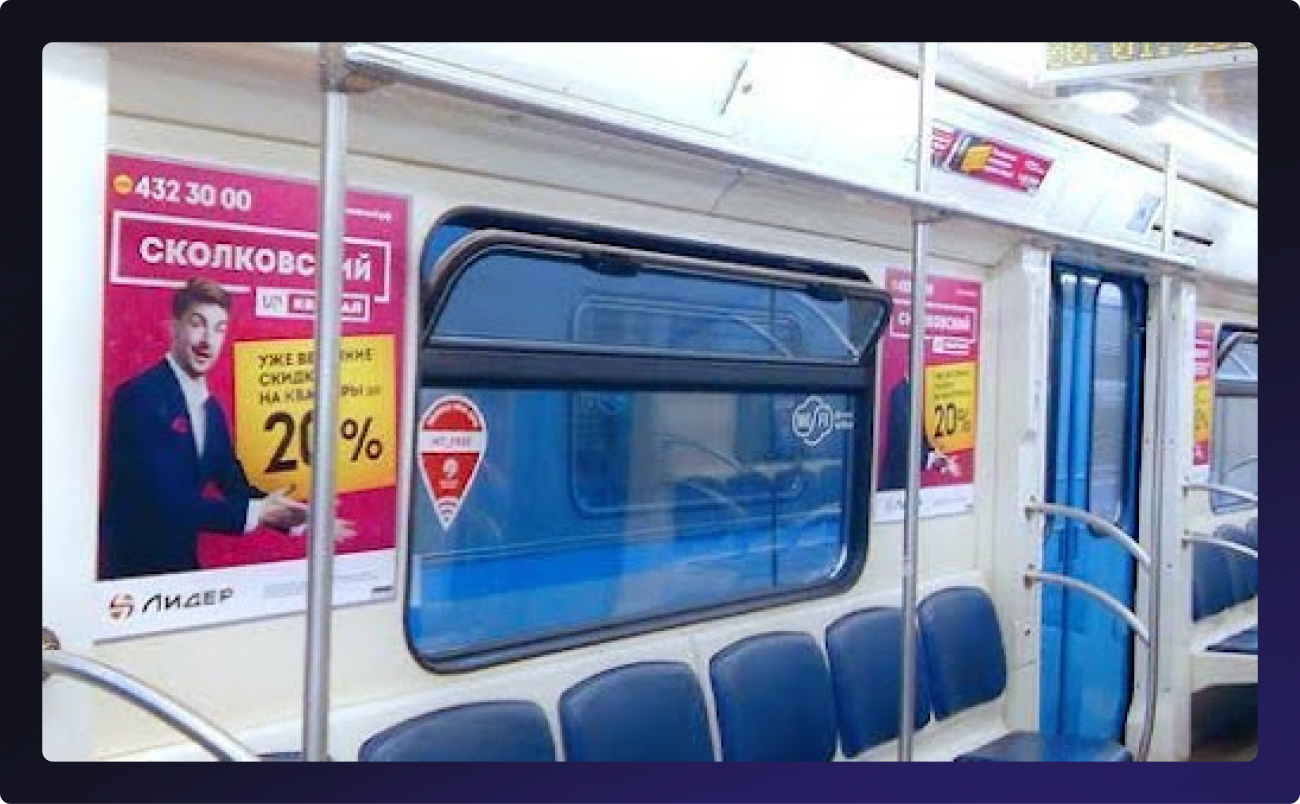
Advertising stickers in a Moscow subway carriage
Light boxes in the subways
These light boxes with built-in backlighting will attract the audience's attention even in the absence of daylight. This advertising design is the perfect choice for small and medium-sized businesses and large companies alike, offering an affordable cost of placement. One common example of advertising light box placement is along escalators leading to and from the subway. The depth of the subway in Russia is one of its defining characteristics. The descent to some stations can take up to five minutes, during which passengers can see the advertising on the light box unobstructed. They are suitable for brands with a limited budget and provide prolonged visual contact.
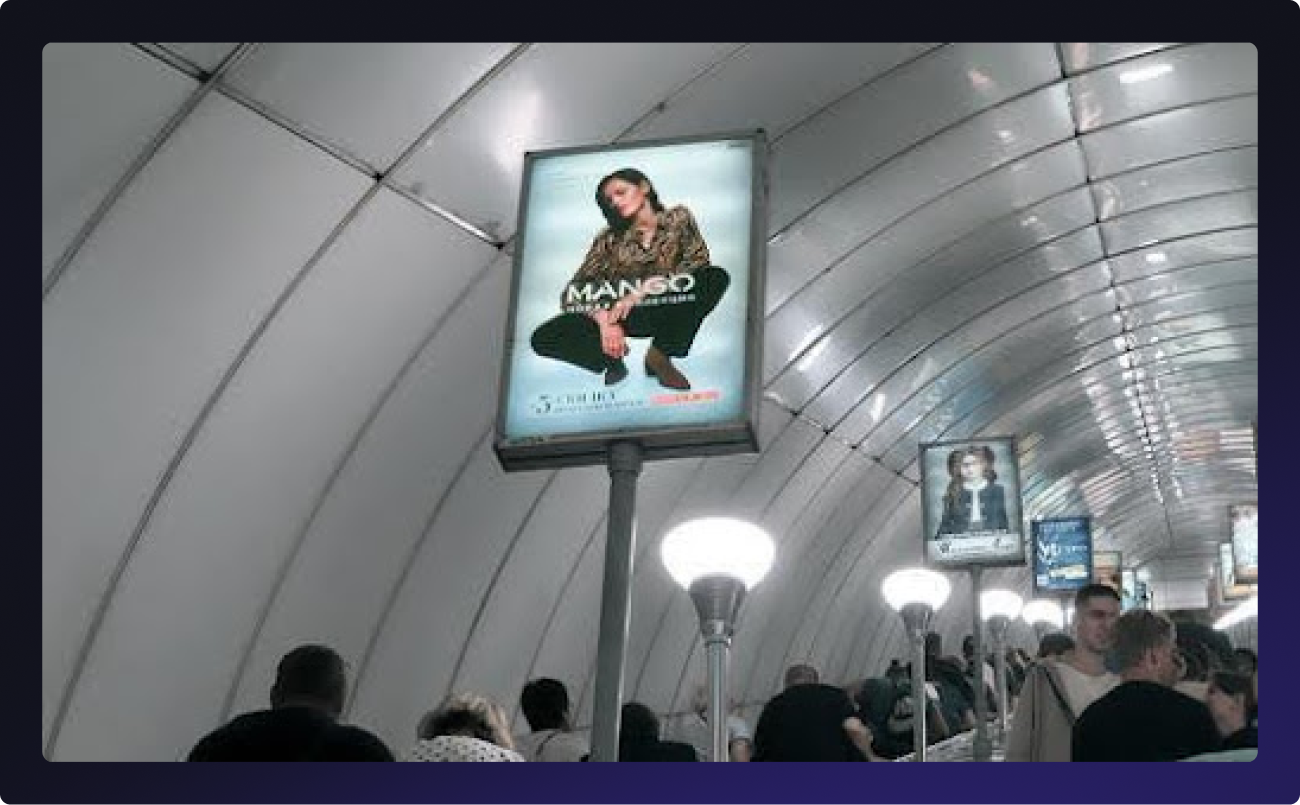
Advertising on 0.615×0.915 mm light boxes on the escalator of St. Petersburg subway
Out-of-the-box advertising creatives in the subway
Let us consider non-standard ways of placing indoor advertising in the subway.
In 2023, the Russian mobile operator MTS launched an advertising campaign in the Moscow subway in support of high-speed internet. The lobby of the Rizhskaya metro station was the chosen location for the advertising. The brand placed an unusual digital screen with curved shapes measuring 4x2.5 meters. The advertising design resembled a "flying carpet" and made a clear association between MTS Internet and this fabulous vehicle.

MTS digital non-standard shape display at the Rizhskaya station of the Moscow Metro
The subway of St. Petersburg provides another excellent example of a non-standard approach to indoor placement. They placed posters with access to the interactive library with QR codes, which allow you to read or download famous works of Russian classics. This creative was part of the In the Subway with a Book project. It was seen at six leading stations of the St. Petersburg subway. QR codes are an effective tool for outdoor and indoor advertising. They allow the audience to access quickly the brand's website.
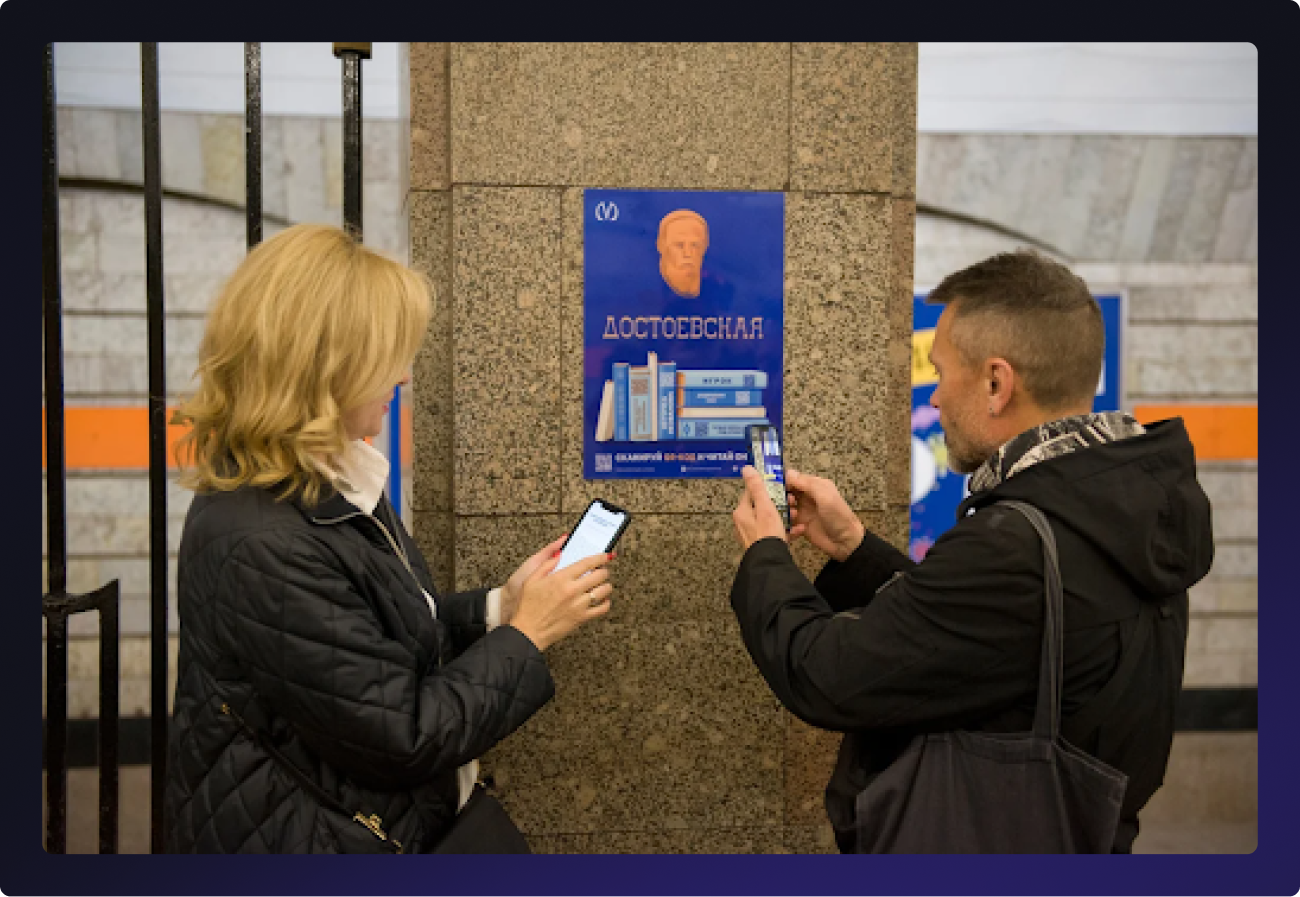
Creative QR-code of the project "In the subway with a book" in the lobby of the St. Petersburg subway
Subway advertising reaches a huge flow of passengers of different ages and incomes every day. They are all potential buyers of goods and services, so they are of interest to advertisers.
Digital city formats, digital screens, light boxes, and stickers—there are plenty of ways to get your message out to potential buyers. Subway advertising is also prioritized in a huge selection of locations. There are half as many advertising opportunities inside any airport as there are inside the Russian subway.
Our special industry report provides invaluable insight into the Russian media market, and it's available to all clients interested in it.
Final thoughts
If you're promoting cosmetics, electronics, fintech, travel services, games, or FMCG, indoor advertising in the metro is a channel with predictable reach and the ability to accurately assess results.
Order a media plan, and we will select cities, stations, formats, and placement periods based on the specifics of your product. We will integrate offline placements with digital tools to enhance the campaign and minimize media waste.
Join 2,000+
of your Peers!
You will be the first to know about Russian marketing insights, news and updates from our agency. Stay tuned!
Get our latest articles delivered to your email inbox and get our exclusive White Paper
"A media buyer's quick guide for effective work in Russia"
for FREE!
How does the Media Buying Market in Russia Work?
Navigating the Media Buying System in Russia

Ready to partner with the specialists in Russian marketing and advertising?
About the Author
Expert in Media Buying. Julia specializes in optimizing and executing strategic media placements across Russia & the CIS region.
Join 2,000+ of your Peers!
Get our latest articles delivered to your email inbox and get our exclusive White Paper "A media buyer's quick guide for effective work in Russia?" for FREE!
You will be the first to know about Russian marketing insights,
news and updates from our agency.
Stay tuned!
We're updating our website's design step by step, so some pages may look different. Thank you for your understanding.
Got it














